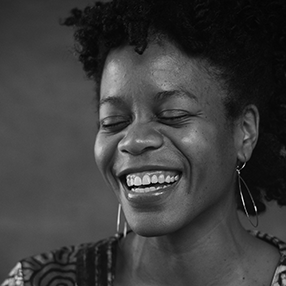after David Hammons’s Close Your Eyes and See Black
1. Smear your forearms with something like shea butter or sunscreen and lean over a bright piece of paperboard, facedown. Hover there, then print your body onto to the paper below. See how your forearms, printed there, make the top half of a diamond?
2. There is no clear narrative. What is clear, scanning the artwork from top to bottom, are details of a naked, muscular torso: two nipples, a hairy chest in the shape of a heart, the elastic band and wrinkled beginnings of a pair of trousers—and strikingly, within the torso, the portrait of a face—cupped by two hands.
3. Close your eyes and see black.
4. What is the texture and mood of your blackness? What seeking, sweetness, or sorrows does it hold?
5. Then the bottom edge of the frame.
6. In Close Your Eyes and See Black, the white space is not white. It is golden, a deep royal hue. Everywhere the body print isn’t is the color of a peeled Georgia peach.
7. Place your hands over your head and make the shape of a diamond.
8. Back to the portrait of a face. It appears like a ghost: centered in the torso, centered in the lower half of the frame. It appears beneath the nipples and above the elastic of wrinkled pants. It appears to be a photographic image of a Black man. It appears this man is closing his eyes, is seeing black.
9. What blacknesses do you see? What blacknesses have printed themselves onto you?
10. To make this body print, David Hammons coated his hair, skin, and clothes with grease and pressed his body onto the paperboard. Then the artist dusted a dark pigment on top, which adhered to the grease’s stickiness.
11. There is no face in the top half of the art work. Instead, a negative space, a rich, golden hue breathes into the space of the diamond.
12. The color of a lucky, double-yolk egg.
13. What must it feel like to shine in shadow; to glow darkly in the sun?
Commissioned by the Guggenheim Museum as part of the 2023 Poet-in-Residence. Reprinted with permission of the poet.

